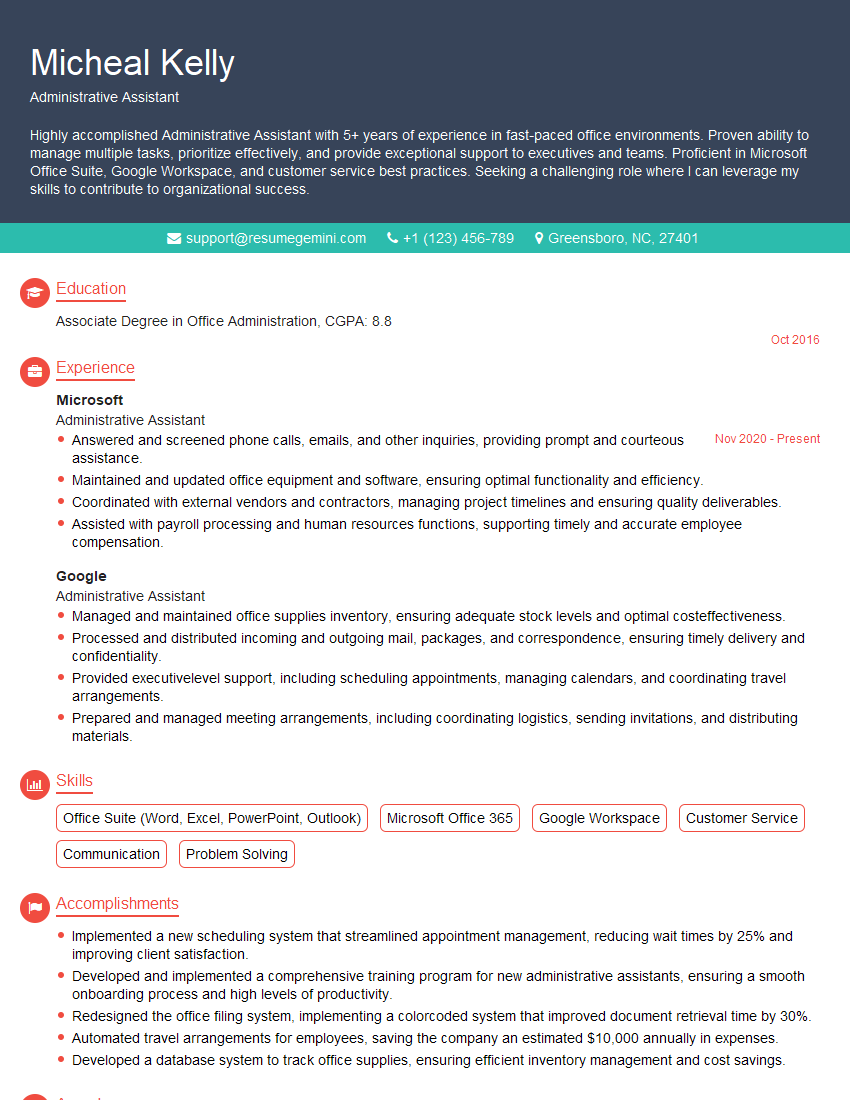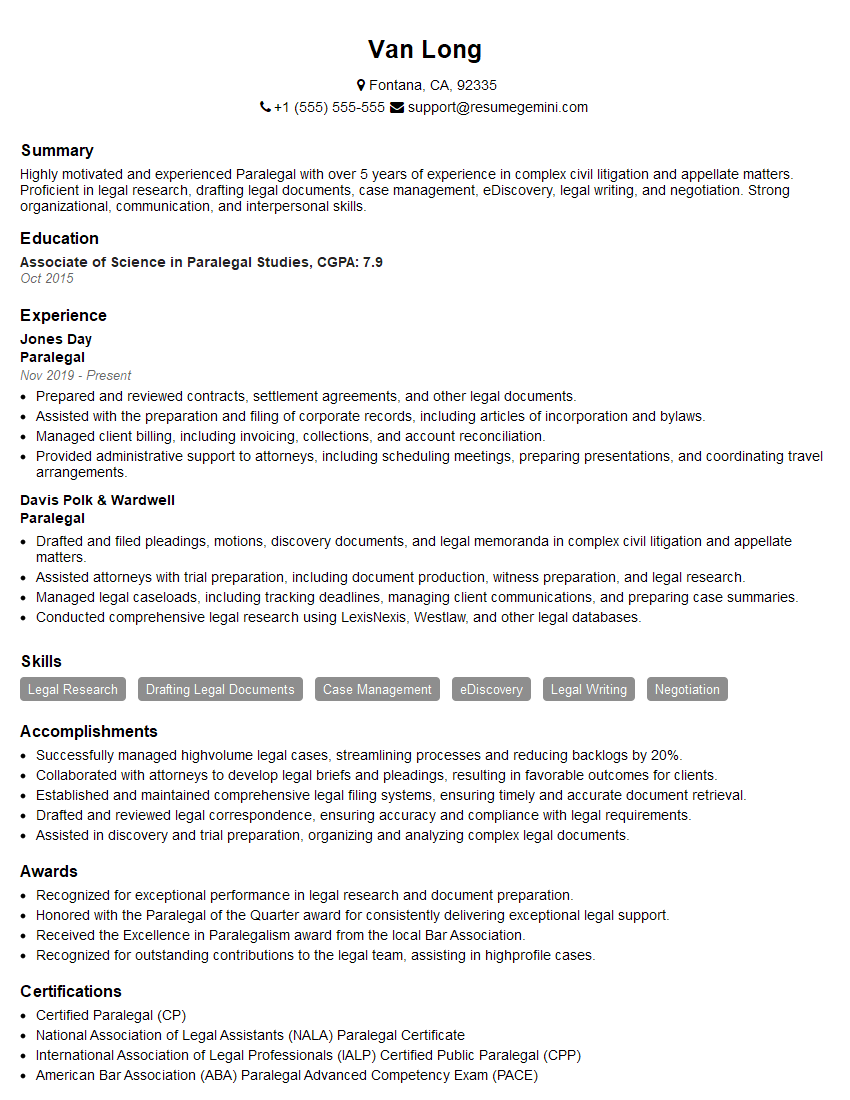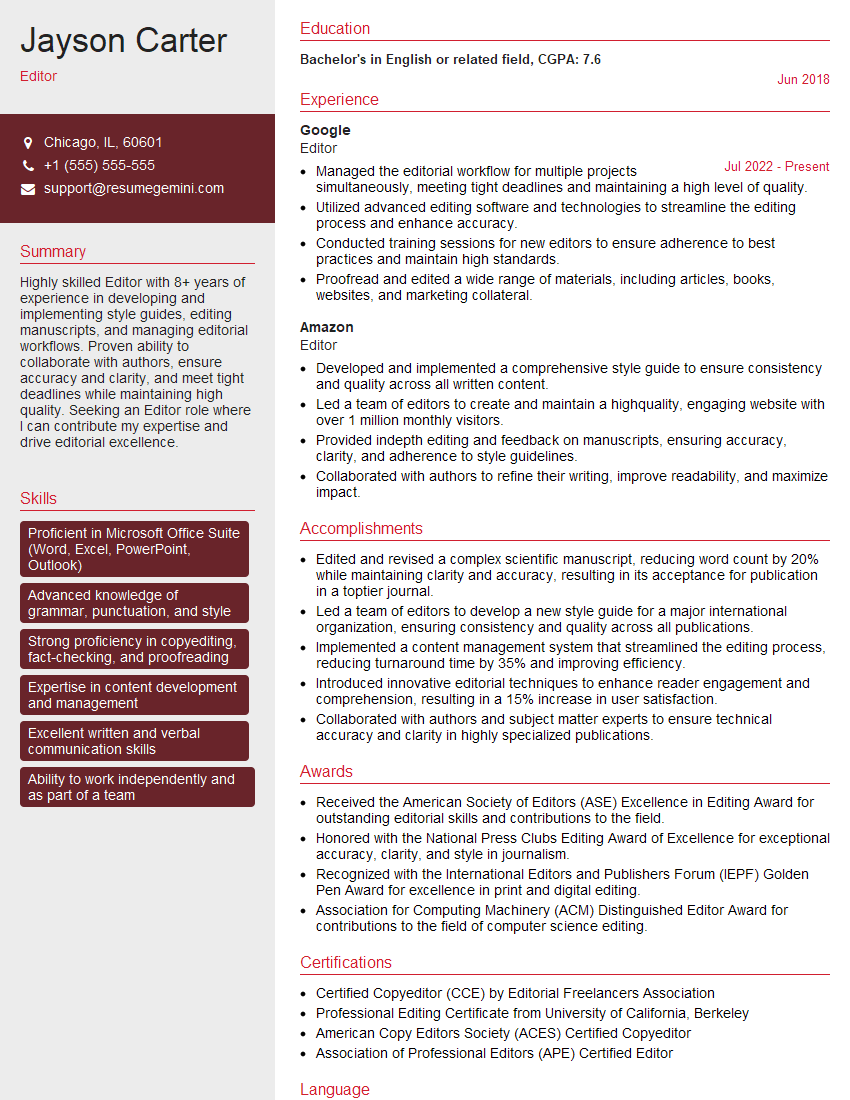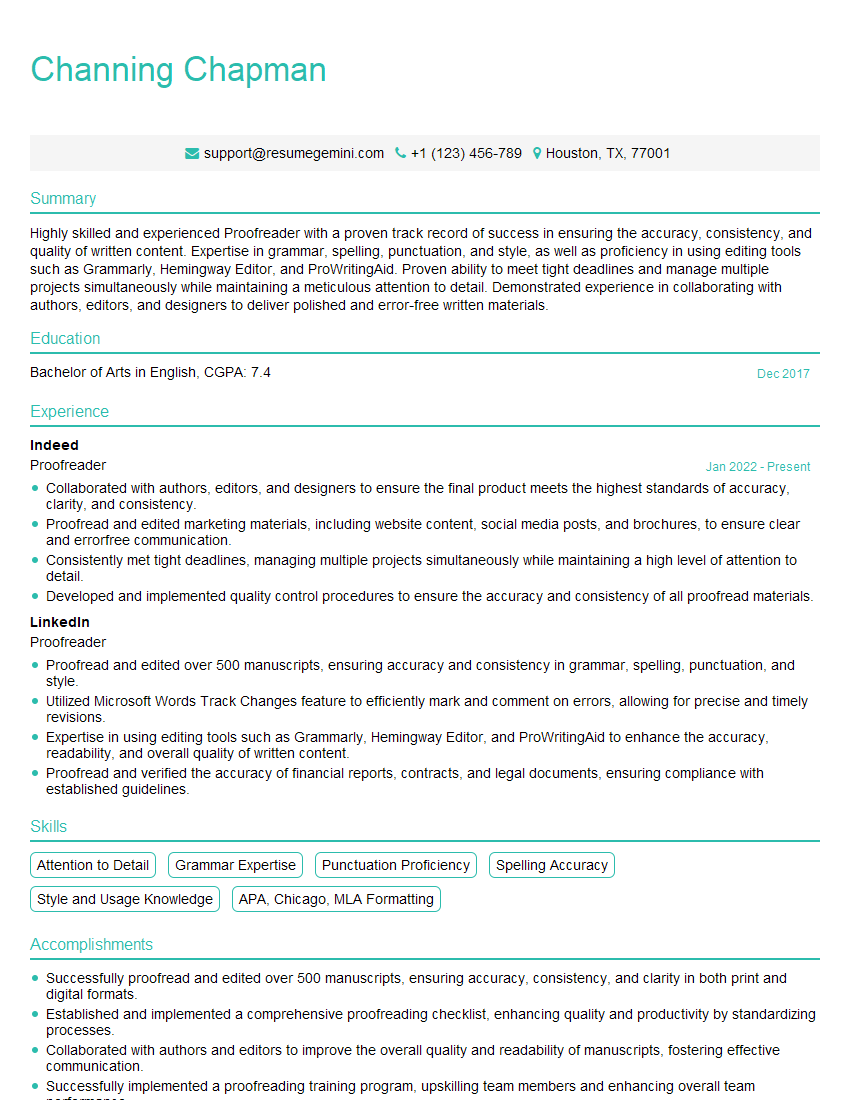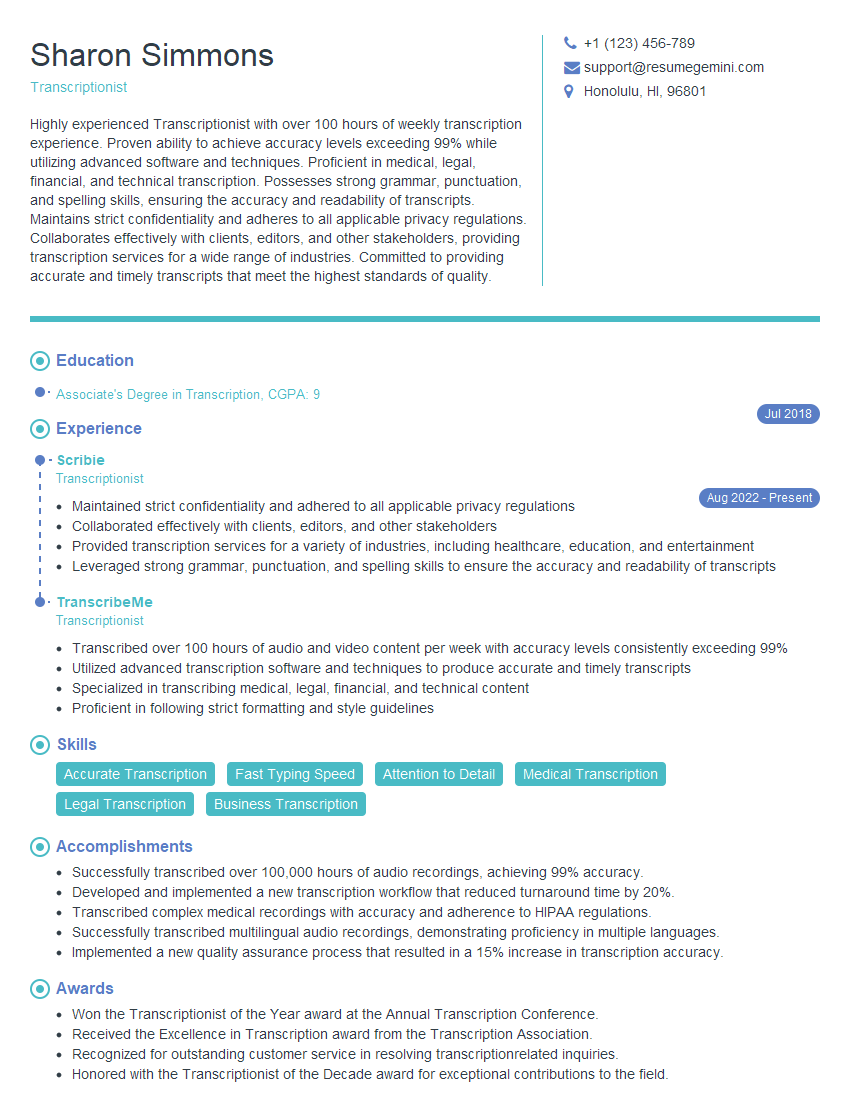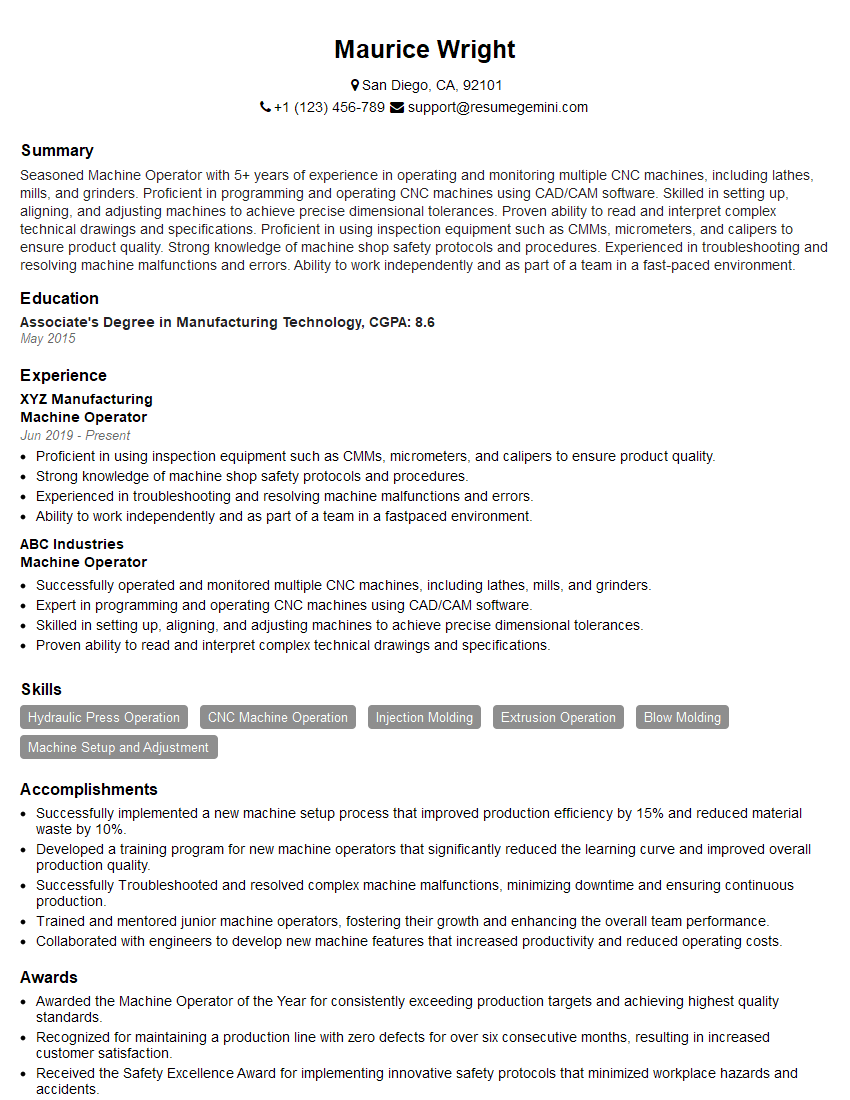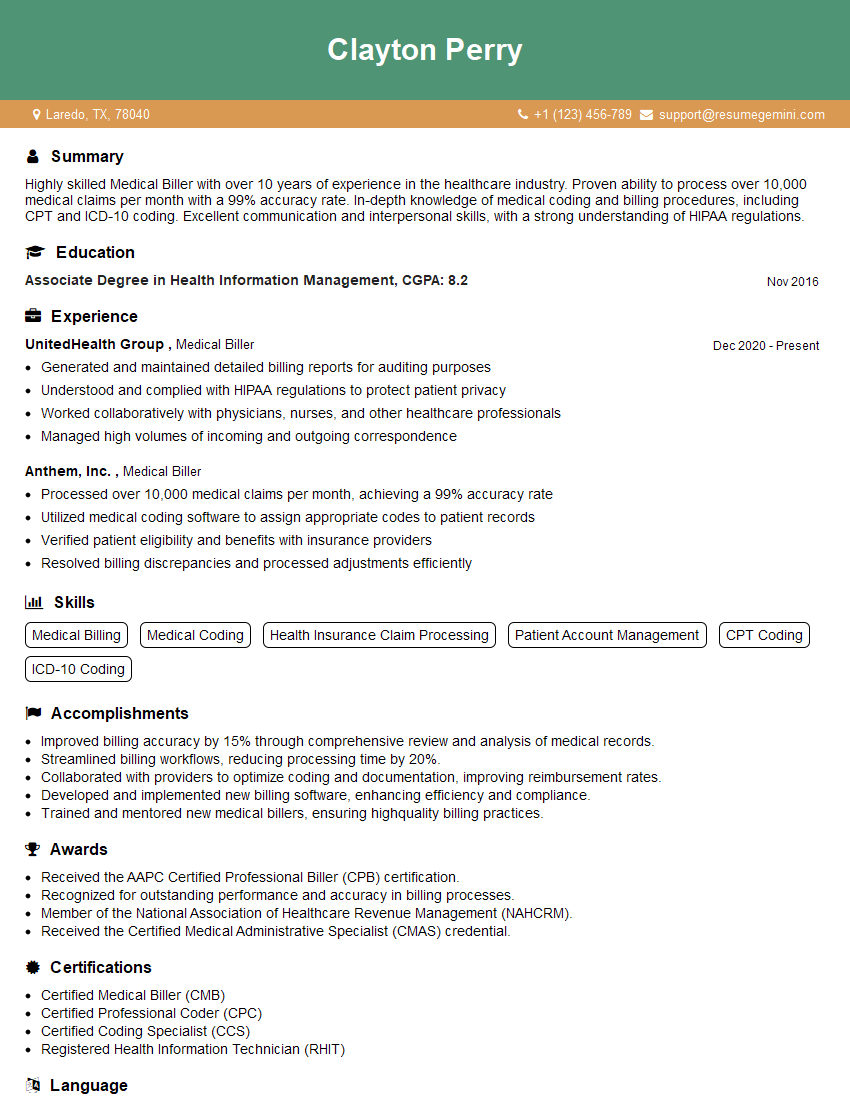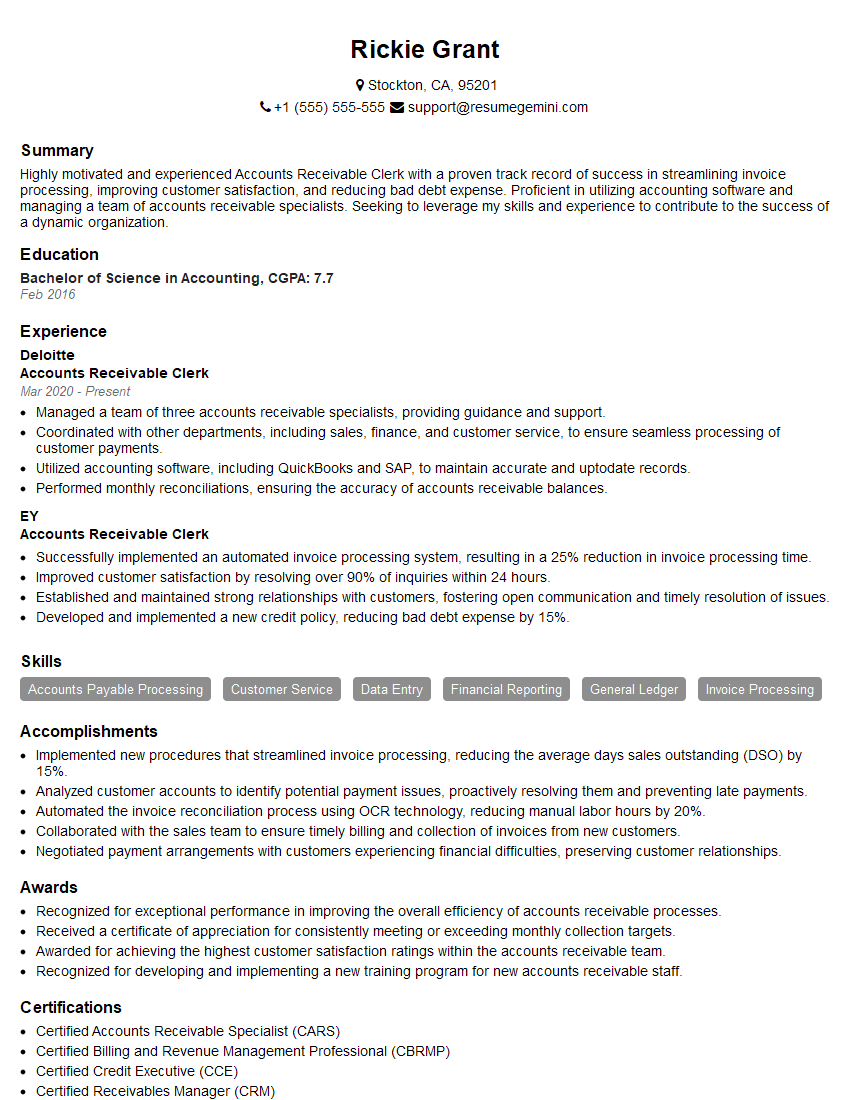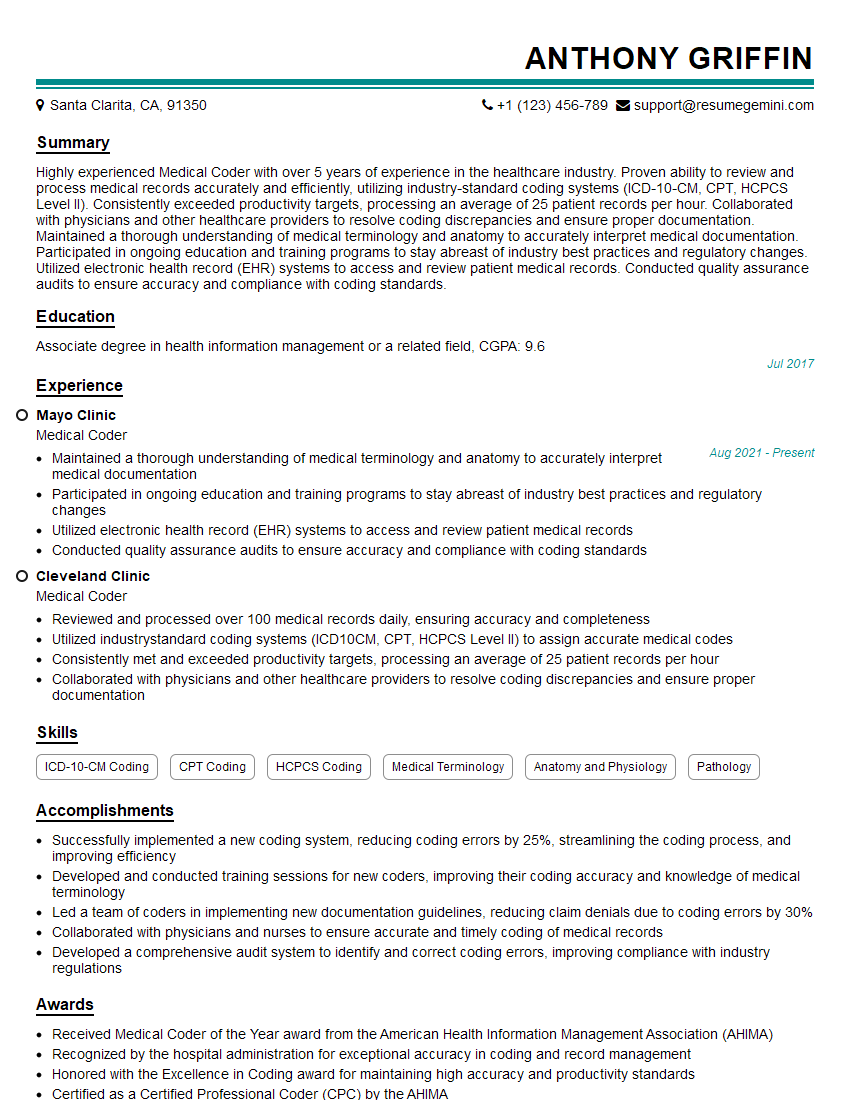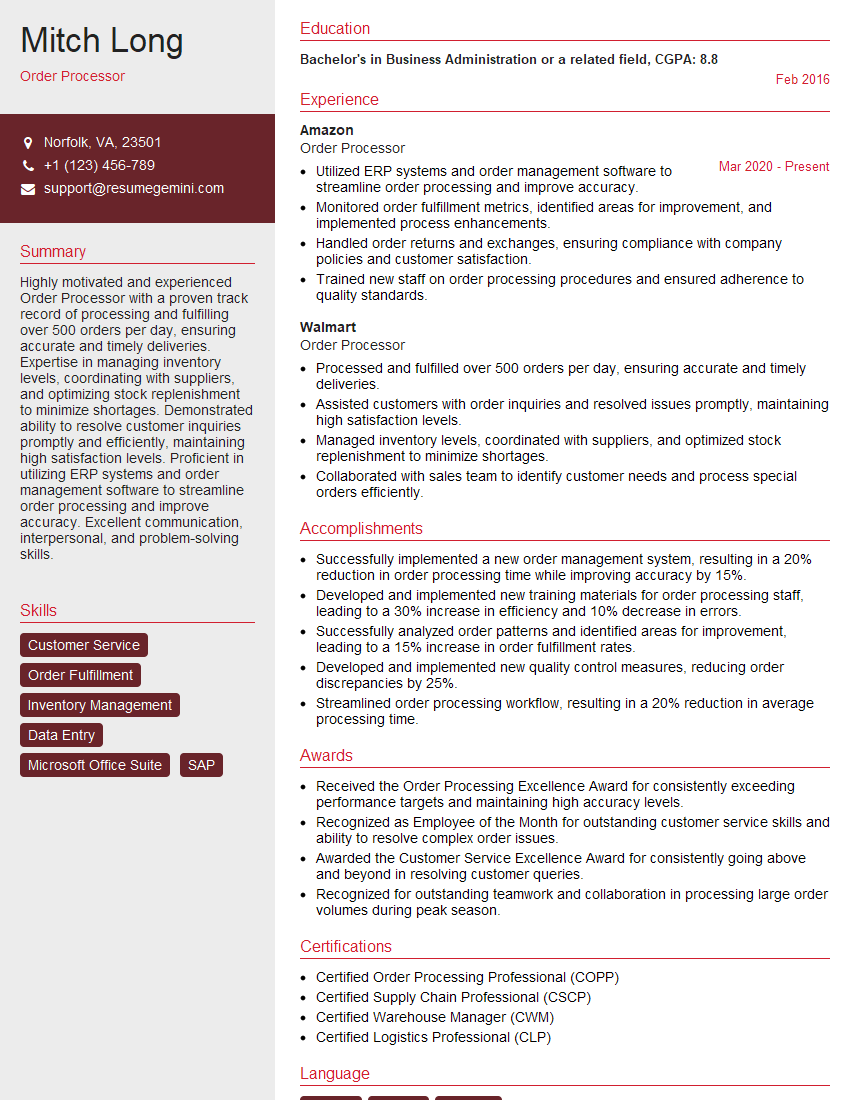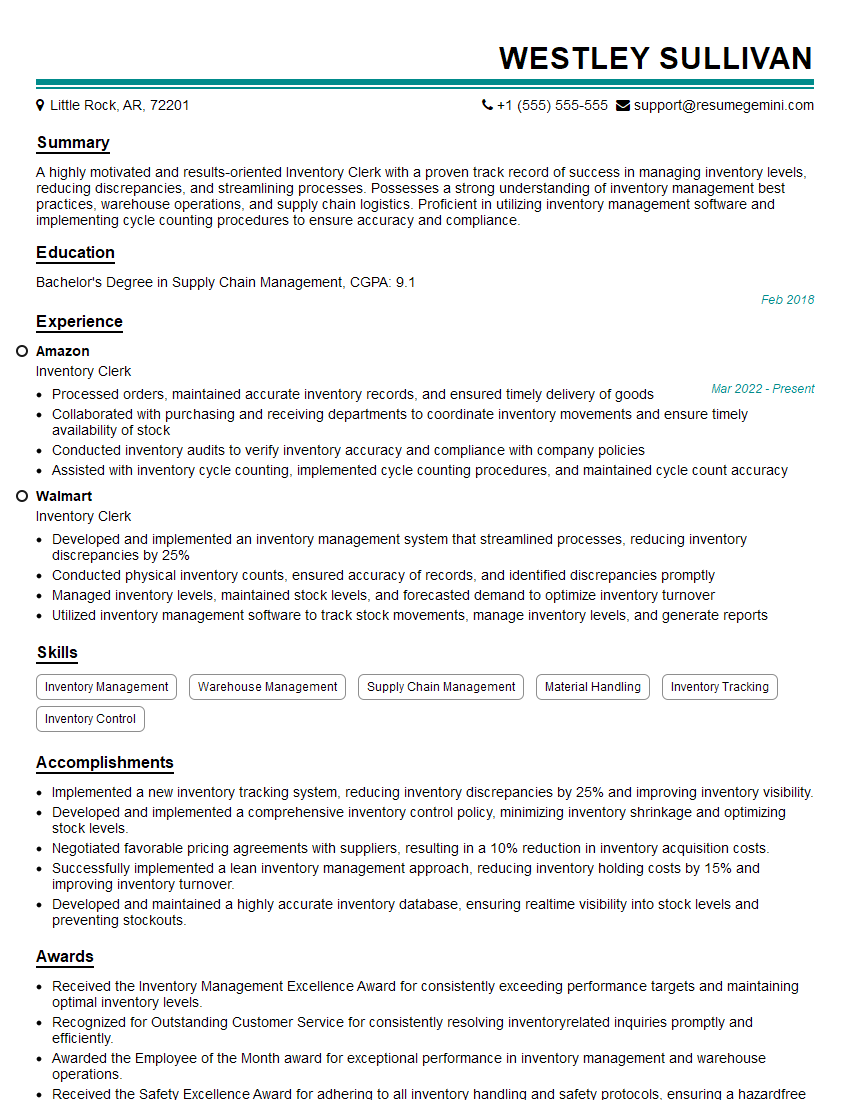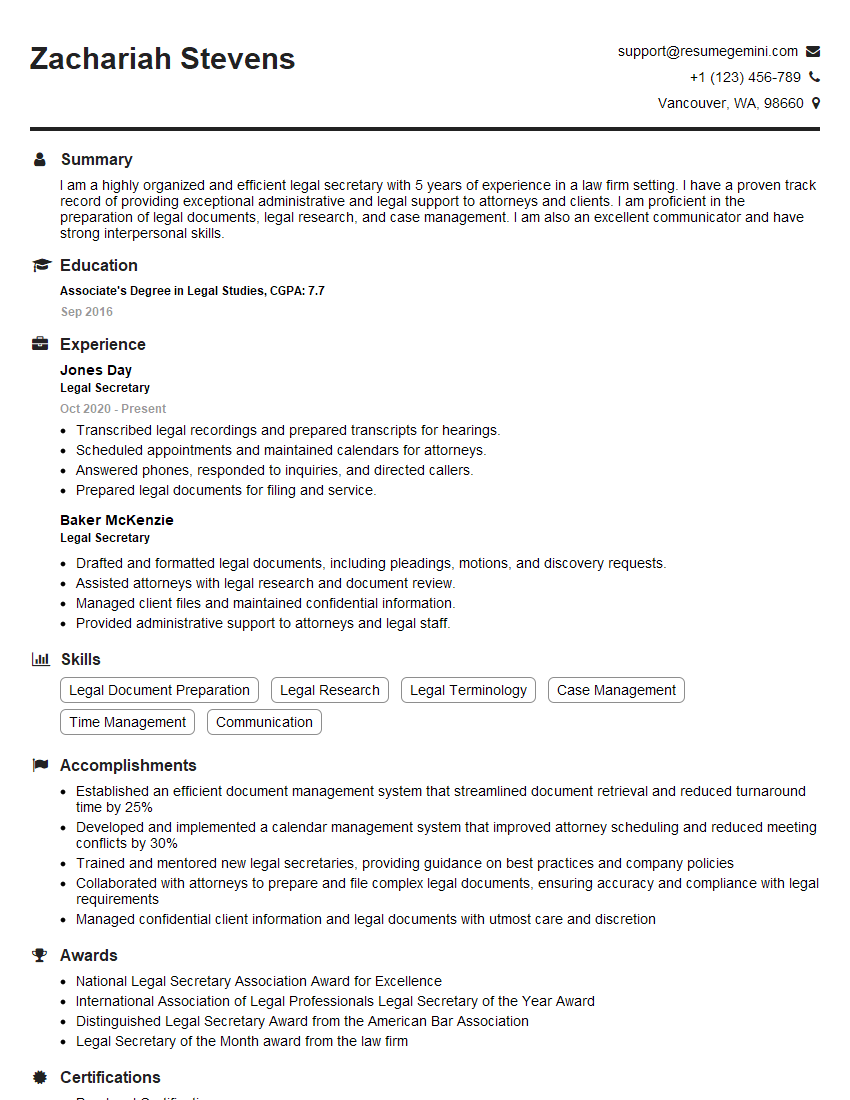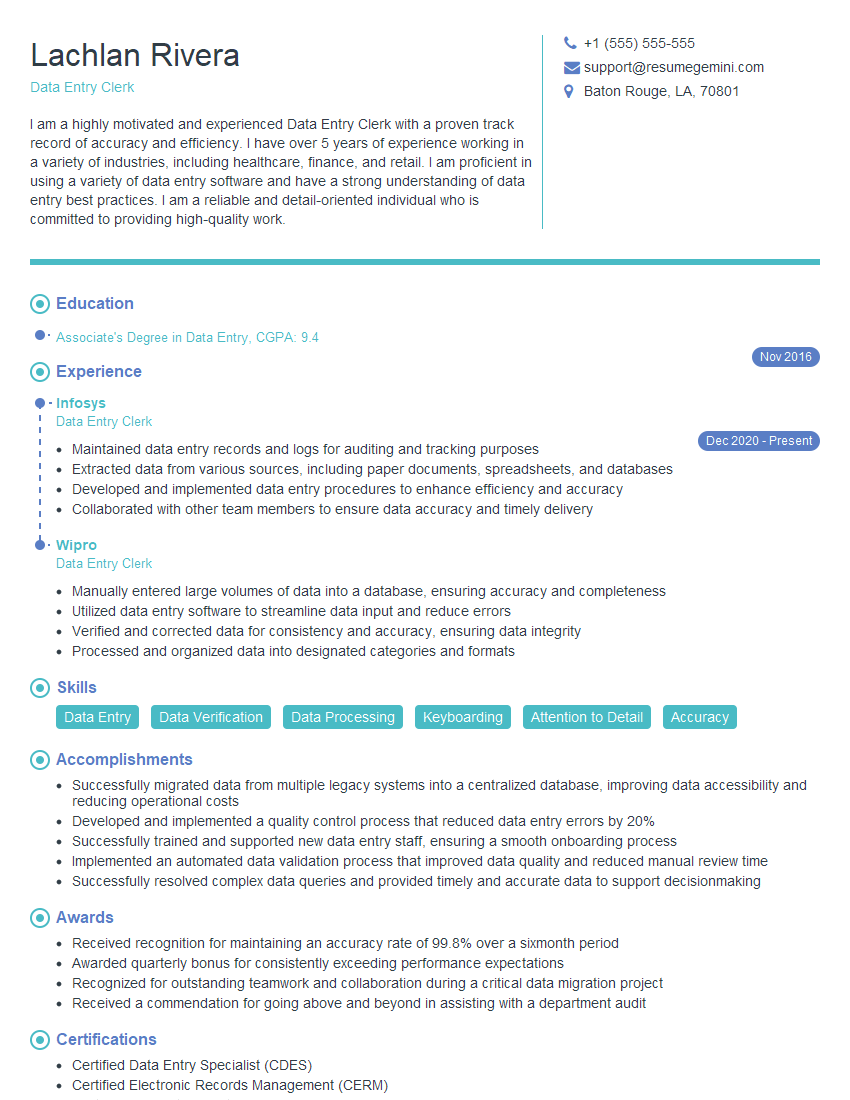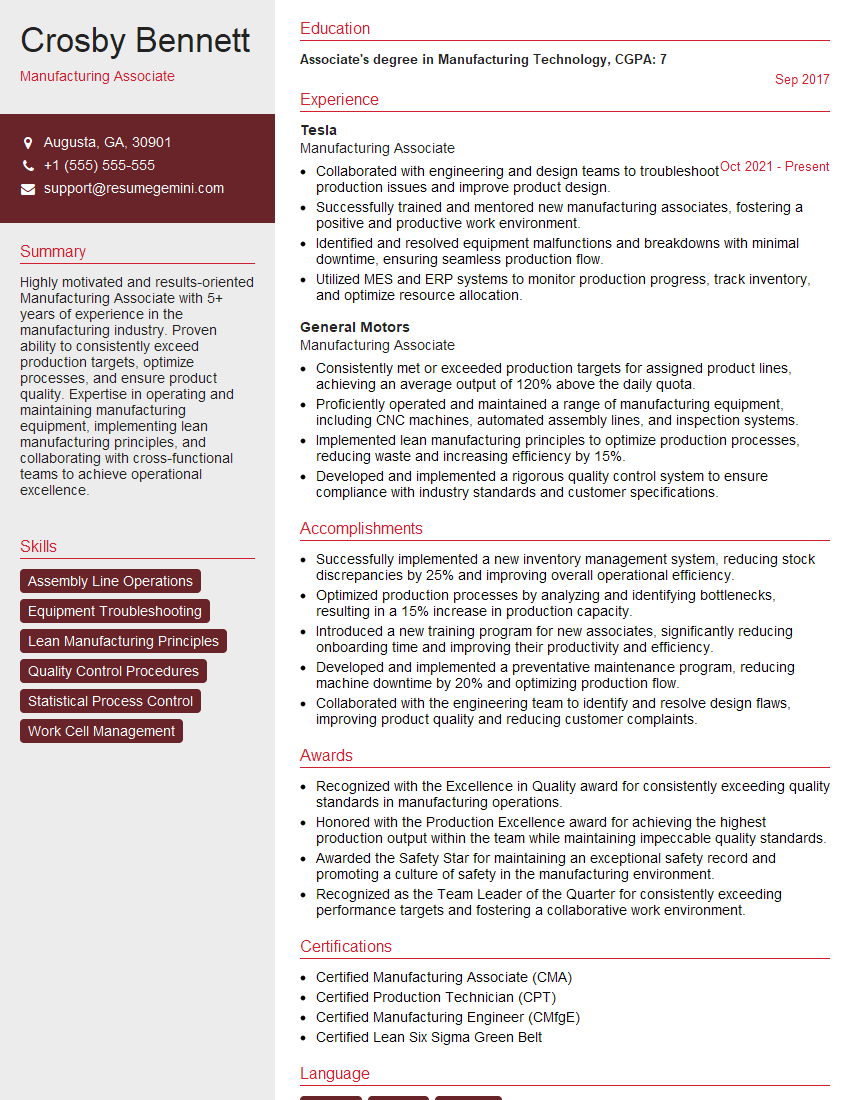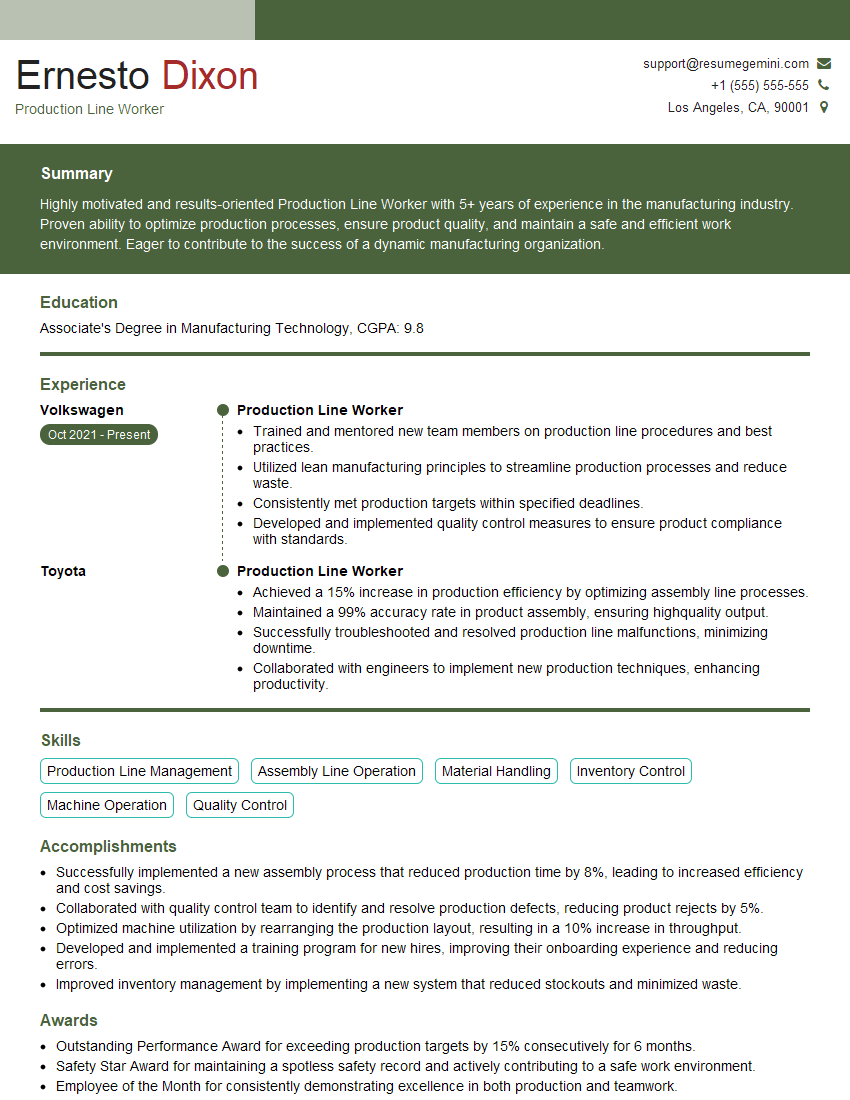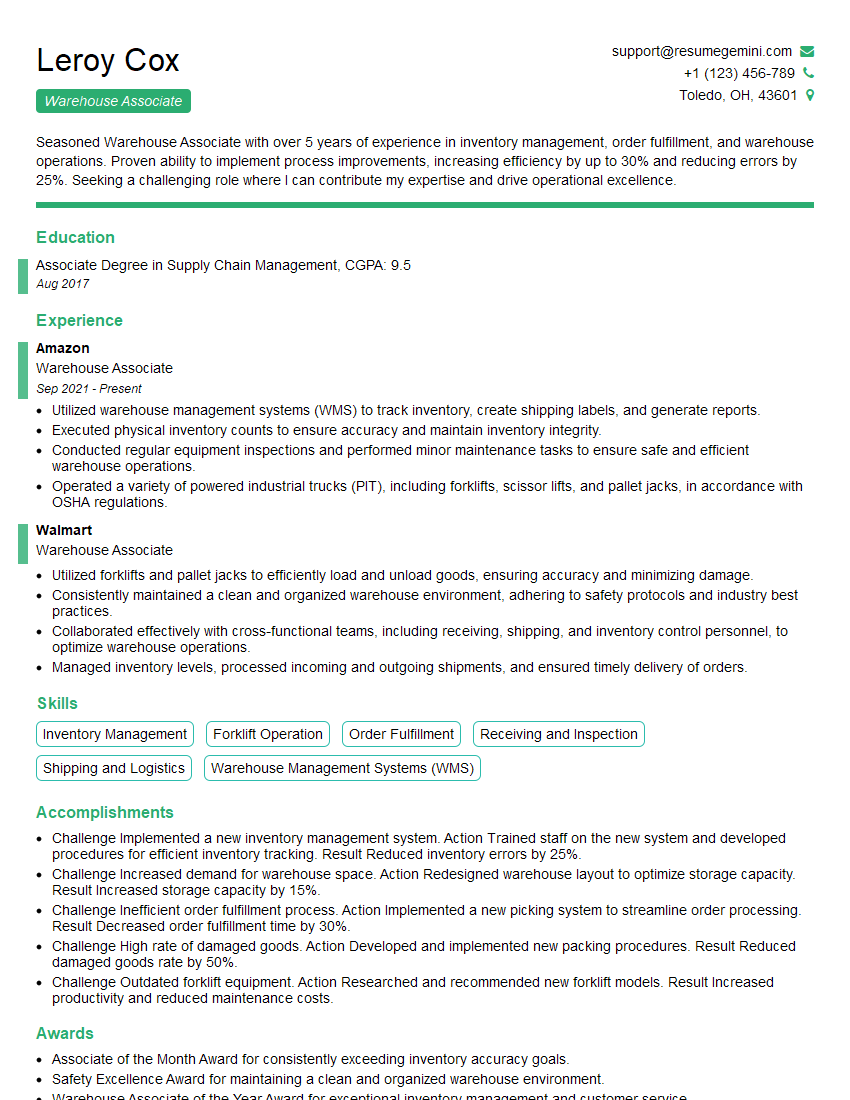Every successful interview starts with knowing what to expect. In this blog, we’ll take you through the top Ability to Handle Repetitive and Demanding Work interview questions, breaking them down with expert tips to help you deliver impactful answers. Step into your next interview fully prepared and ready to succeed.
Questions Asked in Ability to Handle Repetitive and Demanding Work Interview
Q 1. Describe your experience with repetitive tasks. Give a specific example.
Repetitive tasks are a common part of many jobs. My experience spans various roles where I’ve handled high volumes of similar tasks. For example, during my time as a data entry specialist at Acme Corporation, I was responsible for processing hundreds of client applications daily. Each application required inputting the same set of data points into our database: name, address, contact information, and application details. While the process was repetitive, accuracy was paramount. This role demanded meticulous attention to detail and the ability to maintain consistency across all entries.
Q 2. How do you maintain focus and efficiency during prolonged periods of repetitive work?
Maintaining focus and efficiency during prolonged periods of repetitive work requires a multi-pronged approach. I employ several strategies: Firstly, I break down large tasks into smaller, manageable chunks. This prevents feeling overwhelmed and allows for regular short breaks. Secondly, I utilize techniques like the Pomodoro Technique – working in focused bursts of 25 minutes followed by a 5-minute break. Thirdly, I actively listen to focused music or ambient sounds to minimize distractions. Finally, I regularly change my posture and move around to improve circulation and reduce physical fatigue. These methods help maintain alertness and prevent mental burnout.
Q 3. Have you ever experienced burnout from repetitive work? How did you overcome it?
Yes, I have experienced burnout from repetitive work in the past. It happened during a particularly demanding period at a previous job where we were understaffed and deadlines were incredibly tight. I felt overwhelmed, exhausted, and unmotivated. To overcome this, I first prioritized self-care. This involved getting enough sleep, exercising regularly, and eating nutritious food. I also communicated my struggles to my supervisor, who was understanding and helped adjust my workload. Additionally, I engaged in activities outside of work that I enjoyed, allowing me to de-stress and recharge. Finally, I sought feedback on my work processes to identify areas for improvement and streamline my workflow for future efficiency.
Q 4. What strategies do you use to prevent errors in repetitive tasks?
Preventing errors in repetitive tasks involves a combination of techniques. I use checklists to ensure I don’t miss any steps. I regularly cross-check my work against source documents for accuracy. I also take short breaks to refresh my focus and avoid making mistakes due to fatigue. Furthermore, I utilize quality control tools where available, such as automated validation checks in software applications. Finally, I always maintain a meticulous record of my work, allowing me to easily identify and rectify any potential errors if they occur.
Q 5. How do you prioritize tasks when faced with a high volume of repetitive work?
Prioritizing tasks when faced with a high volume of repetitive work involves using a system that balances urgency and importance. I typically use a combination of methods: First, I categorize tasks based on deadlines and potential impact. Then, I leverage tools like task management software (e.g., Asana, Trello) to organize and visually represent my workload. This allows me to clearly see what needs to be done and when. I use techniques such as the Eisenhower Matrix (urgent/important) to further prioritize, focusing on high-impact tasks first. Finally, I communicate with my colleagues and supervisor to ensure everyone is aligned on priorities and to avoid duplicated efforts.
Q 6. Describe a time you had to handle a high volume of demanding work within a tight deadline.
In my previous role, we had to implement a major software upgrade within a very tight deadline – just two weeks. This involved a massive volume of data migration, testing, and user training. The workload was immense and demanding. To manage this, we implemented a detailed project plan with clearly defined roles and responsibilities. We held daily stand-up meetings to track progress and address any roadblocks. We also encouraged open communication and collaboration among the team. We worked long hours, but we strategically scheduled breaks to prevent burnout. Ultimately, through teamwork, effective planning, and diligent effort, we successfully completed the project on time and to specification.
Q 7. How do you stay motivated when performing repetitive tasks?
Staying motivated while performing repetitive tasks requires a conscious effort. I find setting smaller, achievable goals within the larger task helps. I reward myself for completing these milestones. I also focus on the bigger picture and how my work contributes to the overall project or company goals. This provides a sense of purpose and meaning. I also actively seek feedback on my work to ensure I’m making a positive contribution. Finally, maintaining a positive work environment, through collaboration with colleagues and open communication with supervisors, helps keep morale high and fosters a sense of camaraderie and support.
Q 8. How do you adapt to changes in repetitive work processes?
Adapting to changes in repetitive work processes requires a flexible mindset and proactive approach. It’s not about resisting change, but embracing it as an opportunity for improvement and growth. My strategy involves several key steps:
- Understanding the Change: I thoroughly analyze the new process, identifying the key differences and potential challenges. This includes understanding the why behind the change – knowing the rationale helps me accept it more readily.
- Seeking Clarification: If anything is unclear, I actively seek clarification from my supervisor or colleagues. Asking questions prevents misunderstandings and ensures I’m executing the new process correctly.
- Active Learning: I embrace hands-on training and practice. I don’t hesitate to ask for guidance during the initial stages of the transition, and I actively look for opportunities to refine my technique.
- Feedback and Iteration: I actively seek feedback on my performance with the new process. This allows me to identify areas for improvement and refine my approach. Continuous learning and adaptation are crucial.
For example, in a previous role, our data entry system was updated. Instead of resisting, I took the online training, practiced with sample data, and sought feedback from my team lead. This ensured a smooth transition and allowed me to quickly master the new system.
Q 9. Describe your experience working under pressure with repetitive tasks.
Working under pressure with repetitive tasks requires strong organizational skills, meticulous attention to detail, and the ability to manage time effectively. I’ve found that maintaining a calm and focused approach is crucial. My experience has taught me the importance of:
- Prioritization: I prioritize tasks based on urgency and importance, ensuring critical deadlines are met. This prevents feeling overwhelmed and allows for focused execution.
- Time Management: I break down large tasks into smaller, manageable chunks. This helps me track progress, maintain focus, and avoid burnout. Setting realistic goals and adhering to a schedule is key.
- Stress Management Techniques: I incorporate short breaks into my routine to avoid mental fatigue. Simple techniques like deep breathing or stretching can significantly improve focus and productivity under pressure.
- Self-Monitoring: I regularly assess my work quality and pace, ensuring I maintain accuracy even under pressure. If I notice my efficiency declining, I take a short break to reset.
In one instance, I had to process a large volume of invoices before a critical deadline. By breaking down the task into smaller batches, setting realistic sub-goals, and taking short breaks, I managed to complete the task accurately and on time, despite the pressure.
Q 10. How do you handle unexpected interruptions during repetitive work?
Unexpected interruptions during repetitive work can disrupt workflow and affect accuracy. My approach involves minimizing disruptions and effectively managing them when they occur:
- Minimize Interruptions: I communicate my need for focused work periods to colleagues, reducing unnecessary interruptions. Using noise-canceling headphones can also be helpful.
- Prioritize and Delegate: If interruptions are unavoidable, I quickly assess their urgency. If the interruption requires my immediate attention, I address it. If it can wait, I note it down to deal with later. If possible, I may delegate less urgent tasks to others.
- Efficient Return to Task: When returning to my repetitive task after an interruption, I take a moment to re-orient myself, review my previous work, and establish a clear path forward. This ensures consistency and reduces the risk of errors.
For example, if I’m interrupted during data entry, I might use a sticky note to mark my place and make a brief note about the interruption before addressing it. Upon return, I review the last few entries to ensure continuity and accuracy.
Q 11. What methods do you use to track your progress on repetitive tasks?
Tracking progress on repetitive tasks is vital for maintaining efficiency and preventing errors. I utilize several methods depending on the task and its complexity:
- Checklists: For simple, repetitive tasks, a checklist ensures nothing is missed. Each completed item is checked off providing a clear visual representation of progress.
- Spreadsheets: For larger, more complex tasks, spreadsheets allow me to track progress quantitatively. I might track the number of items processed, the time spent on each stage, or other relevant metrics.
- Progress Bars: Using software or applications with progress bars offers a visual representation of progress, boosting motivation and clarity.
- Time Tracking Software: For projects involving multiple repetitive tasks, time tracking software helps identify areas of inefficiency and optimize workflows.
For instance, when processing a large batch of documents, I might use a spreadsheet to track the number of documents processed, the time spent, and any errors encountered. This data helps me assess my productivity and identify potential areas for improvement.
Q 12. How do you ensure accuracy in your work when dealing with repetitive tasks?
Ensuring accuracy in repetitive tasks requires vigilance, attention to detail, and the implementation of quality control measures. My strategies include:
- Regular Self-Checks: I conduct regular self-checks throughout the process to catch potential errors early. This could involve double-checking my work after completing a set number of items or using a different method to verify results.
- Cross-referencing: When possible, I cross-reference my work with original documents or databases to ensure consistency and accuracy.
- Using Technology: Employing technology such as data validation tools or automated checks can significantly improve accuracy. Many software applications offer built-in functionalities to prevent errors.
- Process Documentation: Maintaining thorough documentation of the process helps establish clear standards and aids in identifying and correcting errors.
For example, when entering data, I might use a checksum or compare the entered data to the source document to ensure accuracy. If I notice an unusually high error rate, I investigate the cause and implement corrective measures.
Q 13. What steps do you take to improve your efficiency in repetitive tasks?
Improving efficiency in repetitive tasks requires a combination of process optimization, tool utilization, and mindful work habits. My approaches involve:
- Process Optimization: I identify bottlenecks and areas of inefficiency in the process, looking for ways to streamline or automate them. This might involve re-organizing workspaces, using keyboard shortcuts, or finding more efficient tools.
- Automation: I explore opportunities to automate repetitive tasks using available tools or software. Automation reduces manual effort and frees up time for higher-value activities.
- Ergonomics: I maintain a comfortable and ergonomically sound workspace to minimize fatigue and improve focus.
- Batch Processing: Grouping similar tasks together for batch processing improves efficiency by reducing context switching.
For instance, I might use a macro to automate a frequently performed task in a spreadsheet program. Or, I might reorganize my workspace to make frequently accessed tools more readily available.
Q 14. How do you identify and report potential problems related to repetitive tasks?
Identifying and reporting potential problems related to repetitive tasks is critical for process improvement and preventing errors. My approach is proactive and systematic:
- Error Tracking: I meticulously track any errors or inconsistencies that occur during the process. This data provides valuable insights into areas needing improvement.
- Root Cause Analysis: When errors occur, I conduct a root cause analysis to identify the underlying cause. This helps prevent similar errors from happening again.
- Documentation: I document all identified problems, their root causes, and proposed solutions. This documentation is crucial for sharing information and tracking progress.
- Reporting: I promptly report all identified problems to my supervisor or relevant team members, providing clear and concise information about the issue, its impact, and suggested solutions.
For example, if I notice a recurring error in data entry, I’ll document the error, investigate the potential cause (e.g., unclear instructions, system malfunction), and report it to my supervisor, suggesting possible solutions such as updated training materials or system adjustments.
Q 15. How do you maintain a positive attitude when performing repetitive tasks?
Maintaining a positive attitude during repetitive tasks is crucial for productivity and well-being. It’s like running a marathon – you need to pace yourself and find ways to stay motivated. I employ several strategies:
- Breaking down tasks: Instead of focusing on the overwhelming entirety of the work, I break it into smaller, manageable chunks. This creates a sense of accomplishment with each completed segment, boosting morale.
- Setting realistic goals: I avoid setting overly ambitious targets, opting for achievable milestones that allow for regular positive reinforcement. This prevents burnout and maintains a sense of progress.
- Finding the flow: I focus on getting into a rhythm and concentrating on the process, letting my mind find a ‘flow’ state where the work feels less tedious. This often helps me lose track of time and the repetition becomes less noticeable.
- Utilizing breaks effectively: Short, strategic breaks are essential. I step away from my workstation, stretch, or engage in a brief, unrelated activity to refresh my mind and body. This prevents mental fatigue and keeps energy levels high.
- Seeking variety (where possible): Even within repetitive work, there might be minor variations or ways to switch things up slightly. I actively look for these opportunities to maintain engagement.
- Positive self-talk: I consciously remind myself of the value of my work and the overall contribution I’m making. This positive internal dialogue can significantly impact my perception of the task.
Career Expert Tips:
- Ace those interviews! Prepare effectively by reviewing the Top 50 Most Common Interview Questions on ResumeGemini.
- Navigate your job search with confidence! Explore a wide range of Career Tips on ResumeGemini. Learn about common challenges and recommendations to overcome them.
- Craft the perfect resume! Master the Art of Resume Writing with ResumeGemini’s guide. Showcase your unique qualifications and achievements effectively.
- Don’t miss out on holiday savings! Build your dream resume with ResumeGemini’s ATS optimized templates.
Q 16. Describe a situation where you improved a repetitive process. What was the result?
In my previous role, we manually entered data from physical forms into a spreadsheet. This was time-consuming and prone to errors. I identified the bottleneck as the manual data entry. I proposed, and successfully implemented, a solution using optical character recognition (OCR) software. We scanned the forms, the OCR software extracted the data, and then a verification process was used to identify and correct any errors. The result was a drastic reduction in processing time – from approximately 2 hours per 100 forms to under 15 minutes. Error rates also dropped significantly, from an average of 5% to less than 1%. This improvement freed up valuable time allowing us to focus on higher-value tasks.
Q 17. How do you manage stress related to repetitive tasks?
Managing stress associated with repetitive tasks involves a multi-pronged approach:
- Physical wellbeing: Regular exercise, a healthy diet, and sufficient sleep are crucial for managing stress levels. These factors directly impact my energy and mental resilience.
- Mindfulness techniques: Practicing mindfulness or meditation, even for short periods during the day, helps me stay grounded and present, reducing feelings of overwhelm.
- Time management: Efficient time management techniques, like the Pomodoro Technique (working in focused bursts with short breaks), help prevent burnout. I plan my work strategically to avoid last-minute rushes.
- Ergonomics: I ensure my workstation is ergonomically set up to minimize physical strain, thereby reducing stress and improving comfort.
- Open communication: If stress levels become unmanageable, I openly communicate with my supervisor to explore potential solutions together. This might include adjusting workloads or seeking additional support.
Q 18. How do you handle monotony associated with repetitive work?
Monotony is a significant challenge with repetitive work. To combat this, I employ several strategies:
- Cross-training: Seeking opportunities to learn new skills or take on different aspects of the job, even temporarily, can break up the monotony and provide a refreshing change of pace.
- Setting personal challenges: I challenge myself to improve my efficiency or accuracy, turning the repetitive tasks into a personal contest to improve skills and speed.
- Learning while working: I listen to podcasts, audiobooks, or online courses while performing tasks that don’t require intense concentration. This transforms downtime into a learning opportunity.
- Social interaction: If the nature of the work allows, I interact with colleagues during breaks or during the task itself to maintain social interaction and combat isolation.
- Utilizing technology: I explore ways to automate or streamline processes, reducing the burden of repetitive actions. This makes the work more engaging and efficient.
Q 19. How do you organize your workspace to maximize efficiency when performing repetitive tasks?
Organizing my workspace is paramount for efficiency in repetitive tasks. A well-organized space minimizes wasted time searching for items and helps maintain focus. My approach involves:
- Decluttering: I regularly declutter my workspace, removing unnecessary items to create a clean and efficient environment. A clutter-free desk leads to a clutter-free mind.
- Strategic placement: Frequently used tools and materials are placed within easy reach to minimize movement and wasted time. I use drawer organizers to keep small items organized.
- Ergonomic setup: My chair, monitor, and keyboard are positioned ergonomically to ensure comfort and reduce fatigue, optimizing long periods of work.
- Visual cues: I use visual cues like labels and color-coding systems to quickly locate items and ensure consistent workflow. This reduces errors and improves efficiency.
- Digital organization: I employ a robust digital filing system for documents and data to ensure easy retrieval and avoid searching endlessly for files.
Q 20. Describe your proficiency with relevant software or tools for repetitive tasks.
My proficiency extends to several software tools commonly used for repetitive tasks. I’m highly proficient in spreadsheet software like Microsoft Excel and Google Sheets, including advanced functions like macros and VBA scripting for automation. I’m also experienced with database management systems such as MySQL and SQL Server, allowing me to efficiently manage and manipulate large datasets. Furthermore, I’m familiar with various automation tools such as UiPath and Zapier, enabling process automation and reducing manual intervention. I am adept at utilizing OCR software for data extraction, and possess a working knowledge of Robotic Process Automation (RPA) technologies.
Example VBA Macro in Excel: Sub AutoFillData()...End SubQ 21. How do you ensure the quality of your work when performing repetitive tasks?
Ensuring quality in repetitive tasks requires a systematic approach:
- Standard operating procedures (SOPs): I meticulously follow established SOPs to ensure consistency and accuracy. This eliminates variations that might lead to errors.
- Regular quality checks: I perform regular checks throughout the process, catching errors early on. This prevents the accumulation of minor mistakes.
- Cross-checking: Where possible, I cross-check my work with other data sources or colleagues to identify discrepancies and ensure accuracy.
- Data validation: I utilize data validation techniques to prevent entry of incorrect data. This includes using dropdown lists, input masks, and other constraints.
- Automation of checks: Where feasible, I automate quality checks using scripts or software, reducing manual effort and ensuring thoroughness.
- Continuous improvement: I actively look for ways to improve the process and reduce error rates. This might involve suggesting changes to SOPs or implementing new technologies.
Q 22. What are your strengths and weaknesses when it comes to handling repetitive work?
My strength lies in my ability to maintain focus and efficiency even during extended periods of repetitive work. I’m adept at establishing routines and optimizing my workflow to minimize errors and maximize productivity. I find satisfaction in completing tasks accurately and thoroughly, even when they’re monotonous. However, a potential weakness could be a tendency towards occasional lapses in concentration if the work is excessively repetitive and lacks variation. To mitigate this, I actively implement strategies such as short breaks, mindful stretching, and changing my workstation setup to maintain alertness and prevent burnout.
For example, in a previous role involving data entry, I developed a system of timed intervals with short breaks in between to maintain accuracy. I also implemented a color-coded system to visually break up the monotony and improve focus.
Q 23. How do you collaborate with colleagues when performing repetitive tasks?
Collaboration during repetitive tasks is crucial for maintaining morale and ensuring quality. I believe in open communication and shared responsibility. This includes regularly checking in with colleagues, sharing progress updates, and offering assistance where needed. We might divide tasks based on individual strengths or rotate responsibilities to prevent monotony and maintain engagement. We also utilize tools like shared spreadsheets or project management software to track progress and identify potential bottlenecks.
In one instance, my team was processing a large volume of invoices. We assigned different stages of the process to each team member based on their skill sets and then regularly checked in using a shared spreadsheet to track progress and identify any issues or discrepancies.
Q 24. How do you handle conflicting priorities when dealing with repetitive tasks?
Conflicting priorities are managed through careful prioritization and clear communication. I use techniques like Eisenhower Matrix (urgent/important) to assess tasks and allocate my time effectively. This involves identifying the most critical repetitive tasks and focusing on completing those first. Open communication with my supervisor or team lead is crucial to ensure that priorities are aligned and that I’m working on the most impactful tasks. I also proactively communicate if I anticipate delays due to competing priorities.
For example, if I’m faced with a deadline for a repetitive data entry task while also needing to assist a colleague with a more urgent project, I would prioritize based on deadlines and urgency, ensuring I inform my supervisor of the potential delay in the data entry task. Effective time management and transparent communication are key.
Q 25. Describe your experience with quality control in a repetitive work environment.
Quality control in repetitive work is paramount. My approach involves implementing rigorous self-checks at each stage of the process, using checklists, and adhering to established quality standards. I’m proactive in identifying and reporting errors, suggesting improvements to the process, and continuously seeking opportunities to refine my workflow for greater accuracy. I also utilize automated quality control tools whenever possible to minimize human error.
In my previous role, we used a double-entry system for critical data, which significantly reduced errors. Additionally, I developed a checklist for each stage of the process to ensure complete and accurate data entry. Regular quality checks and feedback loops with team members helped maintain consistently high standards.
Q 26. How do you maintain accuracy and attention to detail during long periods of repetitive work?
Maintaining accuracy and attention to detail during prolonged repetitive work requires conscious effort. I employ techniques such as regular breaks, varied tasks (if possible), and mindful attention to my posture and workspace. I also use tools like timers to encourage short periods of focused concentration, followed by brief rest periods. Utilizing visual cues, color-coding, or auditory reminders can help sustain concentration.
To avoid monotony, I might listen to instrumental music while working, take short walks to stretch my legs, or change my seating position. These small changes can make a big difference in preventing mental fatigue and maintaining accuracy.
Q 27. How do you learn and adapt to new repetitive tasks or processes?
Learning and adapting to new repetitive tasks involves a structured approach. I begin by thoroughly understanding the process, including the steps involved, the desired outcome, and any relevant quality standards. I actively seek clarification if needed and ask questions to ensure a comprehensive understanding. I then practice the new task, gradually increasing speed and efficiency as my proficiency improves. I also utilize any available training materials and actively seek feedback to identify areas for improvement.
For example, when introduced to a new software for data entry, I spent time familiarizing myself with the interface and features through the online tutorials provided. I then practiced the entry process, starting with smaller datasets, and gradually working my way up to larger volumes, regularly checking my accuracy and seeking feedback from colleagues.
Q 28. How do you contribute to a positive team environment when performing repetitive tasks?
Contributing to a positive team environment when performing repetitive tasks involves maintaining a positive attitude, supporting colleagues, and actively participating in team discussions. I believe in fostering a culture of collaboration and mutual respect. This involves sharing tips and tricks to improve efficiency, offering help to colleagues who might be struggling, and celebrating team successes. Open communication and a willingness to assist others build camaraderie and create a more enjoyable work environment, even when the tasks are repetitive.
In one instance, I created a team Slack channel where we shared tips on efficient keyboard shortcuts and discussed strategies for avoiding burnout during our data entry project. This fostered a sense of community and helped us maintain motivation and morale throughout the process.
Key Topics to Learn for Ability to Handle Repetitive and Demanding Work Interview
- Maintaining Focus and Efficiency: Explore techniques for staying focused and productive even during repetitive tasks. Consider strategies like time management, task prioritization, and mindfulness practices to combat monotony.
- Problem-Solving in Repetitive Environments: Discuss your approach to identifying and resolving recurring issues. Highlight instances where you’ve improved efficiency or streamlined processes to address repetitive challenges.
- Adaptability and Flexibility: Demonstrate your ability to adjust to changing priorities and handle unexpected disruptions within a routine-based workflow. Showcase examples where you’ve successfully adapted to new procedures or unforeseen circumstances.
- Stress Management and Resilience: Explain how you manage stress and maintain a positive attitude in demanding situations. Share strategies for coping with pressure and maintaining productivity under challenging conditions.
- Teamwork and Collaboration in Repetitive Tasks: Illustrate your ability to work effectively within a team, sharing responsibilities and supporting colleagues during high-volume or repetitive work. Highlight instances of collaborative problem-solving and mutual support.
- Continuous Improvement and Process Optimization: Discuss your proactive approach to identifying areas for improvement in repetitive tasks. Share examples of how you’ve suggested or implemented changes to enhance efficiency and reduce errors.
Next Steps
Mastering the ability to handle repetitive and demanding work is crucial for career advancement, opening doors to increased responsibility and higher-level positions. Many jobs require consistent attention to detail and the ability to manage workload effectively, even under pressure. To showcase these skills effectively to potential employers, building an ATS-friendly resume is paramount. ResumeGemini is a trusted resource to help you craft a professional resume that highlights your strengths and experiences. We provide examples of resumes tailored to demonstrate your ability to handle repetitive and demanding work, helping you present yourself as the ideal candidate.
Explore more articles
Users Rating of Our Blogs
Share Your Experience
We value your feedback! Please rate our content and share your thoughts (optional).
